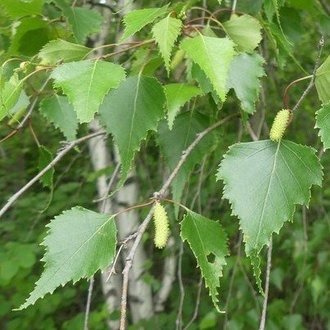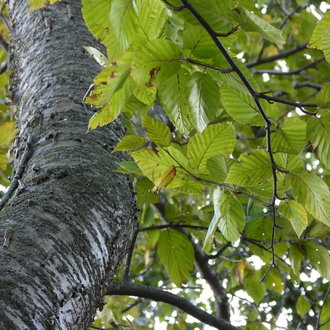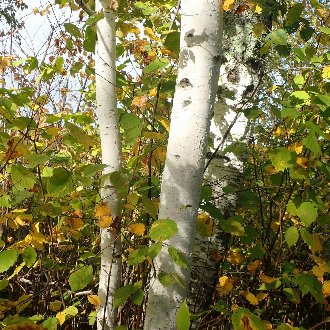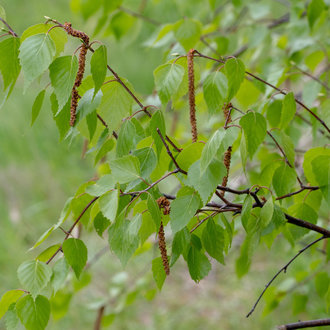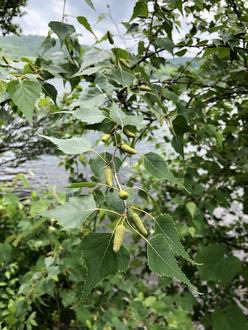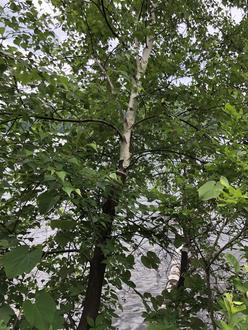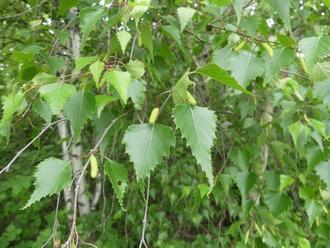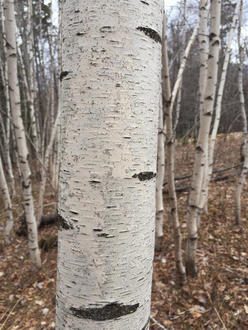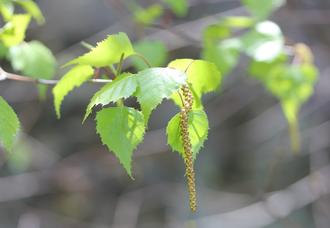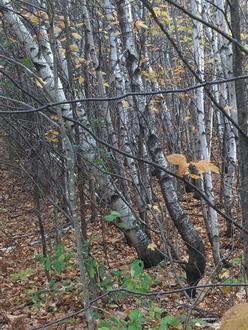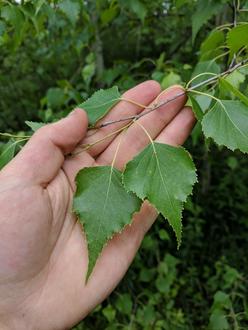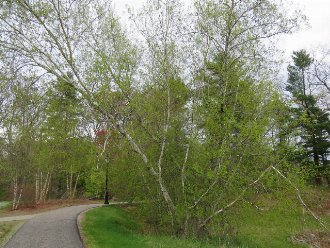Gray Birch (Betula populifolia Marshall)
↑Summary
A fast-growing, short-lived tree native to northeastern North America; mostly a pioneer species.
↑Range - Expand
| Legend | Color |
| Native | |
| Expanded | |
| Native or Expanded | |
| Native or Expanded or Not Present | |
| Native or Not Present |
This tentative map is based on our own research. It may have limited data on Canada and/or Mexico, and there is some subjectivity in our assignment of plants as introduced vs. expanded. Read more in this blog post.
Although this plant occurs somewhere in each of these regions, it may only occur in a small part of some or all of them.
This species has been planted to reclaim mine spoils and is also widely used in landscaping, and has established in the wild south of its native range as a result. These new populations are isolated by distances of a few hundred miles, and could be marked as introduced as well as expanded; we chose expanded because they were mostly in the same or similar ecoregions (in the Applachians) as the northerly part of its range, and because there is likely suitable habitat into which this species could expand, in the areas separating these new populations.
↑Description & Identification
Grows to 20-30ft (6-9m.)
Bark of mature trees is variable in color; can be bright white but often is slightly duller, more grayish, than other white-barked birches. Bark often looks "dirty" due to gray patches of varying sizes, and fine black flecks. Bark of twigs and young branches is much darker in color, bronze to brown, leading to a bold color contrast where young branches meet the trunk. Bark does not peel. There are often shallow, horizontal fissures in the bark, as well as dark triangular patches where branches meet the trunk.
Leaves are roughly triangular, wide and often flat-across at the base, and tapering to a long point at the tip. Leaves are doubly-serrate, with larger points where the veins meet the leaf margin, and smaller serrations in between these points. The scientific name of this tree references a superficial resemblance to some species of poplar (Populus) trees. Foliage is often shiny.
Root system is shallow.
As with other birches, female and male flowers are borne in separate clusters. Staminate catkins (male flower clusters) are longer, narrower, drooping, and usually borne singly, sometimes in pairs. Carpellate (female) catkins are held more upright, shorter and stouter, and project more horizontally from branches, and are replaced by seeds later in the season.
↑Similar Plants
↑Habitat
Found on a wide variety of sites, but only in early-successional stages of forests. Frequently found on abandoned fields, areas that have been clear-cut, or areas that have burned.
Growth is best on moist, well-drained soils, especially near water, but can also be found on dry, sandy or gravely soils.
In most of its range, replaced by spruce-fir forest and/or beech-maple forest.
↑Life Cycle
Seedlings establish readily in full-sun conditions and grow rapidly. Seed production begins around 8 years of age, and seed production is consistently high every year.
Seeds are wind-dispersed. Seeds require a period of cold before germination, and some germinate in the spring, but germination rate in a given year is low. Seeds form a persistent seed bank. Germination is triggered by light levels, and seeds can persist for years in the soil, and germinate in response to disturbance.
Trees resprout if top-killed by cutting, fire, or injury. Stump sprouts produce seed much faster than seedlings and may play a role in regeneration of this species on areas where it is cleared.
Above-ground parts of trees are not particularly resilient; they are easily injured by ice and snow, and also vulnerable to fire: low-to-moderate fires usually top-kill this species, and hot ground fires, common in long periods of drought, kill the entire plant by killing the roots.
We found conflicting claims on the longevity of this tree, but consensus is that it is short even among birches, probably 30-50 years with an unusual maximum lifespan of 150 years.
↑Uses
Sometimes used as a landscaping plant, where it is valued for its small maximum size, and its white bark.
The small size of this species limits its usefulness as commercial timber, but it is sometimes used as firewood.
This species is sometimes intentionally planted to shelter plantings of more desireable tree species that require some initial shelter. The short life-cycle and small maximum size of this species leads it to be quickly overtaken by other species that can be planted or seeded in underneath it. Such usage mimics natural forest succession.
This species has also been used to reclaim disturbed and degraded areas, such as mine spoils.
↑Related Plants
This species is probably most closely related to the European white birch (Betula pendula), which has been introduced in North America, and the resin birch (Betula neoalaskana), which is native to Alaska and northwestern North America. All birches, however, are closely related and can hybridize when they overlap in range and their degreo of polyploidy permits.
This species hybridizes infrequently with mountain paper birch (Betula cordifolia) where their ranges overlap; hybrids are sometimes called "blue birch".
↑Notes
As with other northerly-distributed birches, the white bark of this species is an adaptation to the low angle of the winter sun in northern winters; by reflecting more light, the bark reduces temperature differences that would cause the bark to crack during sunny days in winter.
↑Links & External Resources
• Gray Birch | The Wood Database (About This Site)
• Gray Birch | Fire Effects Information System (FEIS) (About This Site)
• Betula populifolia (Gray Birch) | Illinois Wildflowers (About This Site)
• Betula populifolia (Gray Birch) | USDA PLANTS Database (About This Site)
• Betula populifolia | Go Botany (About This Site)
• Betula populifolia (Grey Birch) | Missouri Botanical Garden Plant Finder (About This Site)
• Gray Birch | Virginia Tech Dendrology Factsheets (About This Site)
• Betula populifolia | Biota of North America Project (BONAP) (About This Site)
• Betula populifolia | NatureServe Explorer (About This Site)
• Betula populifolia | Flora of North America (About This Site)
• Gray Birch | Maryland Biodiversity Project (About This Site)
• Betula populifolia Marsh. (Gray Birch) | Digital Atlas of the Virginia Flora (About This Site)



